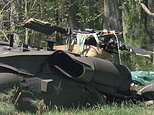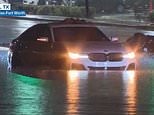Debris from an asteroid deflected by NASA could reach our planet within the next decade, a study says.
The research team ran simulations that tracked 3 million debris particles from the Double Asteroid Redirection Test (DART) mission, which collided a spacecraft with the asteroid Dimorphos in 2022.
NASA launched the mission as a test for deflecting an Earth-destroying asteroid in the future.
The DART mission was a success, but simulations showed that resulting debris could one day reach Mars and the Earth-moon system as meteors.

If these meteors reach Earth, they will not pose any threat to our planet.
Their small size and high speed will cause them to burn up in the atmosphere, creating 'a beautiful luminous streak in the sky,' according to Eloy Peña-Asensio, a research fellow at the Polytechnic Institute of Milan and the study's lead author.
The study appeared online as a pre-print, meaning it hasn't been reviewed by other scientists, but has been accepted for publication by The Planetary Science Journal.
DART was launched from California in November 2021 – and finally completed its 10-month journey when it hit the asteroid Dimorphos in September 2022.
Dimorphos, around 560 feet in diameter, orbits a larger asteroid called Didymos, both of which are around 6.8 million miles away from our planet.
DART hit the space rock at more than 14,000 miles per hour and was destroyed upon impact, while Dimorphos received a 'small nudge' intended to alter its trajectory by a fraction.
The mission demonstrated that the kinetic impactor technique - which involves deliberately ramming a spacecraft into an asteroid - is an effective way to alter an asteroid's trajectory.
In the event that a Potentially Hazardous Asteroid (PHA) were headed towards Earth, NASA could one day use this technique to save our planet.
But scientists are still studying DART's aftermath to ensure that NASA could do this safely.
That's why an international team of researchers wanted to find out where the ejecta - the debris that was produced when DART collided with Dimorphos - could end up.
The team relied on data collected by the Light Italian CubeSat for Imaging of Asteroids (LICIACube), a spacecraft equipped with cameras that accompanied and documented the kinetic impact test.

Drawing on LICIACube's observations, the researchers used supercomputers at NASA's Navigation and Ancillary Information Facility (NAIF) to simulate what could become of the ejecta.
The debris fragments that the team analyzed are small, ranging in size from 30 micrometers to 10 centimeters.
The results showed that some of the debris could reach Earth within a decade, depending on how fast they were moving after impact.
For example, debris traveling faster than 3,355 mph could reach Earth within roughly seven years.
But it will likely be up to 30 years before any of this debris is observed on Earth, the simulations indicated.
'These faster particles are expected to be too small to produce visible meteors, based on early observations,' Peña-Asensio, told Universe Today.
'Nevertheless, ongoing meteor observation campaigns will be critical in determining whether DART has created a new (and human-created) meteor shower: the Dimorphids.'












